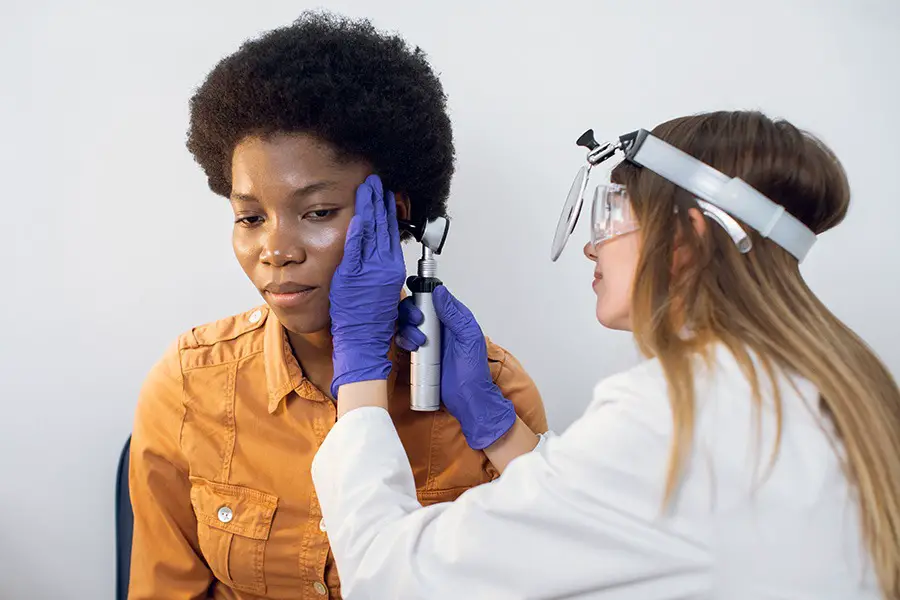Introduction
Embarking on the journey to understand sensorineural hearing loss can be intricate, punctuated by complex scientific terms, intricate medical jargon, and an overwhelming influx of information. This post is designed to demystify this nuanced medical condition and provide comprehensible, precise, and empathetic information to adults dealing with sensorineural hearing loss.
The journey to grasp sensorineural hearing loss isn’t just about decoding the clinical or scientific aspect; it also entails a humanistic perspective. We acknowledge that every conversation about symptoms, diagnosis, or possible treatments involves a person wrestling with the reality of their hearing loss, adapting to alternative ways of interpreting sound, and learning to communicate in altered ways.
In this post, we explore the catalysts and symptoms of sensorineural hearing loss, assist you in recognizing and interpreting the signs that typify this condition. We’ll also investigate the part genetics plays, unravelling how inherited traits can determine the likelihood of developing sensorineural hearing loss. By simplifying intricate procedures like understanding audiograms and contemporary diagnosis methods, our objective is to empower you to take an active role in managing your health.
We’ll delve into the fascinating structure of the ear to fully comprehend sensorineural hearing loss. Understanding this intricate architecture will enable you to envisage the journey of sound from your surroundings to your brain, laying the foundation for grasping how and where sensorineural hearing loss transpires.
Our approach throughout this journey is empathetic and respectful. We salute the fortitude it takes to adjust to sensorineural hearing loss and the bravery in seeking knowledge and resources. We’re here to accompany you, step by step, as you venture into understanding your sensorineural hearing loss. We hope that this post provides not just insight, but also comfort and reaffirmation of the resilience and adaptability of the human spirit.
Tweak Digital Hearing Amplifier
Experience the epitome of sophisticated sound with Tweak, the revolutionary device that brings a new dimension to your auditory experience. Harnessing the power of innovative patented technology, Tweak offers you the freedom to fine-tune your hearing with a diverse range of amplification options. Whether you prefer a subtle enhancement or a more pronounced boost, Tweak empowers you to effortlessly customize your acoustic world.
Crafted with meticulous care and expertise, Tweak represents the brilliant collaboration between an esteemed audiologist and a team of dedicated acoustic engineers. Their collective passion for impeccable sound quality shines through in every detail of this remarkable device. Designed to elevate your hearing capabilities across any environment, Tweak utilizes cutting-edge technology to ensure that you can fully engage with the sounds that matter most to you.
Unlock the extraordinary potential of affordable sound quality with Tweak. By leveraging the latest advancements in digital technology, this ingenious device delivers an auditory experience that rivals that of prescription hearing aids. With premium-grade components at its core, Tweak offers you uncompromising performance without breaking the bank. Immerse yourself in a world of enhanced sound, where clarity and richness seamlessly merge to create an exceptional listening experience.
Dissecting the Causes and Symptoms of Sensorineural Hearing Loss
The principal cause of sensorineural hearing loss is damage to the inner ear or the nerve pathways connecting the inner ear to the brain. Various elements can contribute to this damage, including aging, loud noise exposure, certain drugs, illnesses, genetic syndromes, or even a traumatic head injury. In many instances, it’s a blend of several factors that culminate in hearing loss.
The symptoms of sensorineural hearing loss often begin subtly. You might struggle to follow conversations in a noisy setting or hear a persistent ringing noise in your ears, a condition known as tinnitus. Many people also notice a gradual decrease in their ability to perceive high-pitched sounds or a change in the quality of sounds. Acknowledging these symptoms is the first stride toward seeking help and understanding your personal journey with sensorineural hearing loss.
Unravelling the Role of Genetics in Sensorineural Hearing Loss
Genetics play a vital role in numerous cases of sensorineural hearing loss. Specific genes are integral to the development and operation of the auditory system. Mutations in these genes can lead to defects in the auditory system’s development or function, resulting in hearing loss.
A myriad of genes are implicated in sensorineural hearing loss, and research to identify and understand all of them is ongoing. Several genetic syndromes associated with sensorineural hearing loss are now recognized, including Usher syndrome, Pendred syndrome, and Waardenburg syndrome. Grasping the genetic aspect of sensorineural hearing loss can aid individuals and families in understanding their hearing loss cause and provide crucial information for future family planning.
Deafness: A Journey of Challenges and Triumphs
Understanding Audiograms: Decoding the Diagnosis of Sensorineural Hearing Loss
Audiograms, visual representations of a person’s hearing ability, are pivotal diagnostic tools for sensorineural hearing loss. It measures the quietest sounds one can hear at various frequencies or pitches, usually presented as a graph with frequency on the horizontal axis and loudness on the vertical axis.
An audiogram can discern both the type and degree of hearing loss. In sensorineural hearing loss, the pattern typically depicts a substantial reduction in hearing sensitivity, especially for higher frequencies. While the audiogram might appear complex at first, comprehending it can be an empowering step in managing your hearing loss.
11 ways to improve sleep better with tinnitus
Contemporary Techniques for Diagnosing Sensorineural Hearing Loss
Apart from audiograms, modern diagnosis methods like Otoacoustic Emissions (OAEs) testing and Auditory Brainstem Response (ABR) testing play a significant role in diagnosing sensorineural hearing loss. OAEs testing assesses the outer hair cells in the cochlea’s function, while ABR testing measures the electrical activity of the auditory nerve and brainstem.
In certain instances, imaging methods like MRI or CT scans might be employed to visualize the inner ear and auditory pathway structures. Genetic testing is becoming increasingly common, particularly for congenital or early-onset sensorineural hearing loss. These advanced techniques allow doctors to make more precise diagnoses, leading to personalized and targeted treatment plans.
QUIZ - AVAILABLE TREATMENTS FOR TINNITUS
The Structure of the Ear: Insights into Sensorineural Hearing Loss
Understanding the ear’s anatomy is fundamental in grasping how sensorineural hearing loss occurs. The ear is a sophisticated organ, divided into the outer ear, the middle ear, and the inner ear. Sound waves pass through the outer ear, vibrate the middle ear’s eardrum, and finally reach the inner ear, where they are converted into electrical signals for the brain to decode.
Within the inner ear lies the cochlea, a spiraled structure housing tiny hair cells. These hair cells move with the vibrations and transform them into electrical signals. In sensorineural hearing loss, these hair cells or the nerve pathways to the brain are damaged or defective, hindering the brain’s reception of sound signals.
Conclusion
In this empathetic exploration of sensorineural hearing loss, we have navigated through its causes, symptoms, and genetic factors. We have demystified audiograms and illuminated modern diagnosis techniques, highlighting the processes doctors employ to ascertain the type and extent of hearing loss. We’ve delved into the intricate anatomy of the ear, unveiling how inner ear or nerve damage can result in this common form of hearing loss.
The journey through sensorineural hearing loss can be daunting, riddled with new terminologies and concepts that can seem intimidating initially. But with knowledge and comprehension, it becomes manageable. Understanding the causes and symptoms, genetics’ role, audiogram nuances, the diagnosis process, and the ear’s basic anatomy equips you with the foundation to make informed decisions about treatment and coping mechanisms.
Remember, throughout this journey, you are not alone. Millions of adults globally share the experience of sensorineural hearing loss. They grapple with the same questions, fears, and curiosities. Empathy and understanding, both self-generated and from others, are potent tools on this path. As we continue to discover more about sensorineural hearing loss, the hope for novel treatments and interventions strengthens. With each research breakthrough and technological progression, we inch closer to a world where sensorineural hearing loss doesn’t equate to silence, but rather a different manner of appreciating life’s sounds.

Decoding Silence: An Analytical View on the Advances in Conductive Hearing Loss Research and Treatment
This analytical article sheds light on conductive hearing loss, offering an in-depth exploration of its genetic factors, treatment advances, and promising experimental therapies.

Embracing the Melody of Life: Navigating the Journey with Conductive Hearing Loss
A blog post delving into the experiences and challenges of living with conductive hearing loss, discussing its impact on everyday life, social interactions, mental health, and the potential benefits of hearing aids and cochlear implants.





